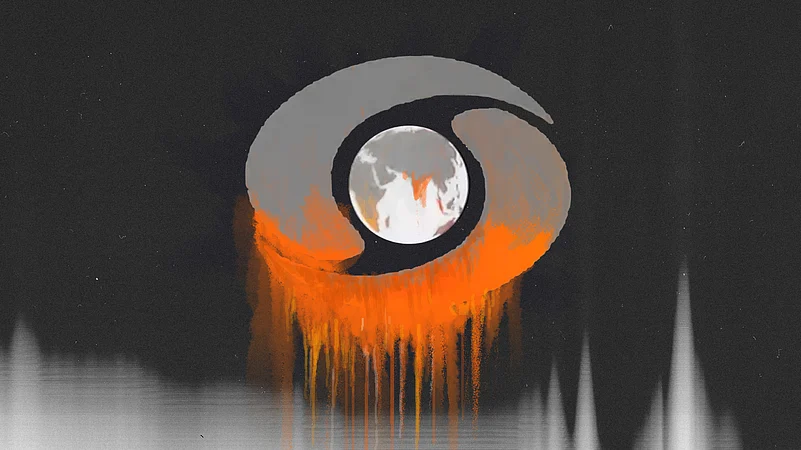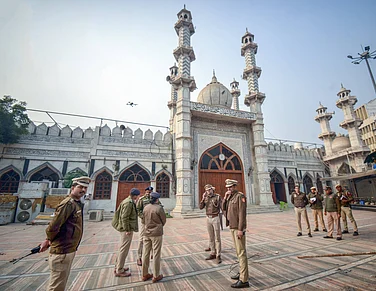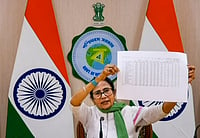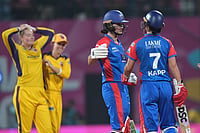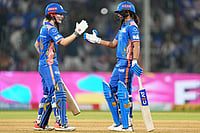Public broadcaster Prasar Bharati's decision to change the colour of Doordarshan's Hindi and English news channels' logo from red to orange has pushed it into the eye of a political storm as the country is witnessing, arguably, its most hotly-contested Lok Sabha elections ever.
As the move is being seen by the Opposition as well as a section of the people as yet another attempt at saffronisation by the ruling party, Prasar Bharati CEO Gaurav Dwivedi dismissed the allegations.
He has pointed the colour being orange, not saffron; that the logo of DD India (English news channel) was revamped to the same colour ahead of the G20 summit. Dwivedi further added that the change was implemented to make sure the two news channels from the same group follow the same visual aesthetic.
The DD Eye logo was originally designed by Devashis Bhattacharyya of the National Institute of Design (NID) picked by Prime Minister and Minister for Information & Broadcasting, Indira Gandhi.
The Doordarshan logo with its broad cultural significance has witnessed the evolution of India’s socio-political and media landscape. Many critics have pointed out that the change in colour, although not uncommon, has been met with criticism with the saffron acting as a jarring political signifier in today’s political climate. Since the days of DD’s colour agnostic logo, the logo has seen numerous changes to its colour, form and shape.
"It's meant to be a 2-D design. Honestly, I don't think any colour belongs to anybody. The first Doordarshan logo—the black and white 2D logo which appeared on television—had a deep imprint on a wide cross-section of viewers. The original 2-D logo or the ident was put forth to support motion graphics, representing a cosmic imagery which was further enhanced by the theme music, and this made for a logo which was extremely visually pleasing,” Pinaki De, an award-winning graphic illustrator told Outlook on the change and its nuances.
“I feel any colour wouldn't look good on the logo. From a designer’s point of view, the very idea of doing it in colour is not a great decision. Doordarshan is dynamic, and captures the excitement of movement. There's a sense of familiarity which bloomed for us with the tune, and thus the original design retains so much visual comfort.”
He notes, most of the time very few design ideas permeate governmental quarters when it comes to decisions of this sort.
“The signature monochrome logo had already become a part of public consciousness, and I, personally, don't think it was necessary. This might be nostalgia speaking, but I personally feel, use of colour in whatever form would be jarring. The motion graphics represent a cosmic momentum, arriving from the darkness of the cosmos. Branding through colour is also important, but I don't think the new 3D design with a globe at the core of it makes a lot of aesthetic sense to me,” he adds.
Talking of the trajectory of the logo, he says, “The journey started with black and white monochrome and traversed through saffron, blue, yellow and a palette of colours. The first time colour TV arrived in 1982, the DD logo, in a form of colour aberration appeared saffron to represent a ball of fire/rising sun. And thus, people have talked about how this new colour goes back to the original. But the original dates back to the days of black and white transmission, where the elegantly superimposed 2D logo lies etched in memory. Personally, from a designer's perspective, the morphing of the logo to a 3D design and the addition of colour to something of immense cultural significance, did not sit well with me."
Speaking about the socio-cultural impact of such logos, Debkumar Mitra, visiting faculty, National Institute of Design (NID) says, “Essentially, logos establish a brand or a product, lending a sense of identity to it, and whenever there's a change in the logo, there must be a serious reason for it. And with something which is so culturally significant, a change in the logo isn't a light decision to make. Of course, considering the political climate and the situation, there would be questions on the new colour, but here is a decision to change a very well established and accepted logo - two very important keywords here.”
Expressing his views on the change, he adds, “Logos are not that simple. There is concrete thought behind it and rounds of trials to check for popularity. I feel, this time around, this has been rushed through. What was the need for the change? If the change would have been that necessary, there should have been public consultation or a process which took its due course when it comes to a visual change concerning the country's public broadcaster. And the timing of the move certainly raises questions as well. When we are addressing the semiotics, the discussion gets complex. We have to factor in the association, the imagery and the colour beyond the surface aesthetics of it.”
Mitra feels any form of art cannot be rejected because it doesn't cater to a certain sense of preference and there should not be blind inconsideration of art. “Personally, it doesn't look great. I don't know how it's going to register on screen in motion and the way it will be accepted. It's the people's broadcaster at the end of the day. It was a nice logo, and I didn't see a point in changing it suddenly. For instance, considering decision-making when it comes to something culturally significant, before the yellow cabs came to New York, there was a debate surrounding what colour the taxi cabs should be. Yellow was decided upon as it registers from a distance. What's that reason here? What's the change supposed to signify? I don’t think it is the issue of the colour registering better on screen. Any change, be it colour or shape has a great impact on the consumer base.”
Mitra maintains that colour aesthetics need to be thoroughly examined and especially in the case of something which holds national significance. “Beyond the obvious questions of political connections, I don't see the colour and the shape fitting the definition. If it's supposed to represent a rising sun, what's its association with the country? A change in the country's public broadcaster's logo needs to be a process, not a rushed through decision."







